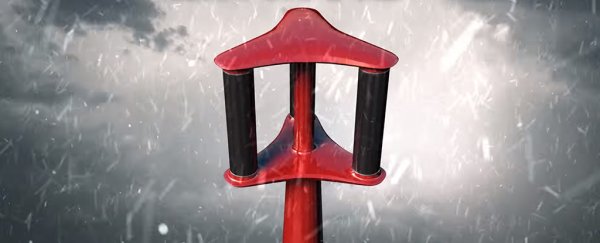A Japanese engineer has invented the world's first typhoon-powered wind turbine - an electricity generator designed to harness the energy packed inside tropical cyclones.
Engineer Atsushi Shimizu says an array of his generators could power Japan for up to 50 years from a single typhoon - and considering six such storms have hit the country this year, we're talking about a lot of potential energy.
"Japan actually has a lot more wind power than it does solar power - it's just not utilised," Shimizu told Junko Ogura and Jenni Marsh at CNN. "Japan has the potential to be a superpower of wind."
According to Shimizu, who founded green energy company Challenergy in 2013, the wind turbines Japan imports from Europe are not suitable for the country's specific climate. In particular, they have an unfortunate tendency to get damaged by typhoons.
That's where these custom-made turbines come in. While the technology has yet to face an actual typhoon, it's designed to cope with unpredictable and violent wind patterns, thanks to its omnidirectional axis, and its adjustable blade speeds ensure that it don't spin out of control.
Key to the invention is the principle of the Magnus effect - the way air curves around anything that rotates (like a basketball), and applies pressure on it at the same time.
In this case, it allows the blades around the turbine to generate movement - which you can see the video below. At the same time, the central rod can be tightened to slow down or stop the blades, regardless of the external forces generated by the typhoon.

In the company's simulated tests, the turbine achieved a 30 percent efficiency level. That's lower than the normal 40 percent, but then again, normal turbines can't operate in typhoons.
And the reduced power efficiency might not be such a big deal, anyway, given the massive amount of energy we're talking about here. In one go, typhoons can produce a level of kinetic energy that's half the entire electrical generating capacity of our planet. The only issue is being able to physically trap it.
But there are certainly challenges ahead. Even if Shimizu and his team figure out how to catch all the energy from a typhoon, current battery technology might not even be capable of storing it.
Still, let's take this one step at a time. The researchers installed their first prototype in Okinawa in July, and are now waiting for a chance to test it with a real typhoon.
Japanese authorities are particularly keen to find new energy sources right now, after the disaster at Fukushima derailed its nuclear energy program. Roughly 84 percent of the country's energy is currently imported.
But if Shimizu's turbine can prove that it can take on - and harness - the energy of an actual typhoon, it could be the answer to making Japan more self-reliant in the future.
"We know our chances are slim," Shimizu acknowledged to Peter Rothenberg at Tech In Asia. "But there is a chance and this is a technology that we need. I feel like Don Quixote taking on the windmills. He lost, but we are going to win."
